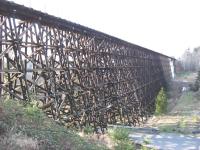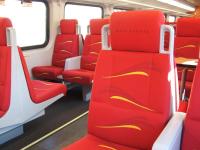Eastside Rail Now's proposal is for much more than just retaining the existing railroad on the Eastside and utilizing it as the core of a light rail transit system.
The proposal additionally calls for transforming the railroad, inclusive of its spacious right of way, into a true multi-purpose corridor and providing substantial amenities such that it would become a destination in itself rather than just a means of getting to other destinations.
A True Multipurpose Right of Way
The existing functions of the Eastside railroad include the popular Spirit of Washington dinner train, freight service to about a dozen local industries and an emergency bypass for the only other north-south rail line within hundreds of miles. The track (with some modifications) has more than sufficient capacity to both maintain these functions and to also serve as the core of a regional light rail transit system for the Eastside.
Moreover, at roughly 100 feet in width for most of its length, the right of way is sufficiently wide for two tracks (there is currently only one on most of the line), as well as for a trail for bicycles, joggers and pedestrians. Each track requires a minimum of only about 15 feet, thus leaving as much as 70 feet in the case of two tracks. There could even be separate trails for pedestrians and bicycles.
The remainder of the right of way could serve as a linear nature preserve both because of its ample width and because of the minimal adverse environmental effects of railroads and trails. This linear reserve would be linked to other open spaces along the route and help provide a migration route for wildlife.
 | |
| (click to enlarge) |
Transit Vehicle Amenities
An important goal of a transit system's should be to not just provide transportation but to also make the total experience as pleasant as possible. This includes making the ride as comparable as practical, and even superior in some ways, to traveling in one's own automobile. Among the qualities of such a system are competitive speed, frequent service, moderate fares, availability of comfortable seats, safety, pleasant scenery, minimal noise, ease of entry and exiting, ease of transporting items (purchases, bicycles, etc.) and freedom to engage in various activities to the extent that they do not annoy others. Fortunately, these qualities are easy to achieve in a well-designed and well-managed rail transit system.
A technological advance of recent years that can add considerably to user convenience and safety as well as to system speed is low floor vehicles. Because the floors are flush with the station platform heights, the need for steps and mechanical lifts is eliminated, thereby making entry into and exit from the transit vehicles easier and faster for everyone (including people with wheelchairs, bicycles and baby carriages) and minimizing station dwell times.The convenience for users of bicycles and other wheeled vehicles, as well as for people carrying bulking packages, can be further increased by providing spaces near the doors.
 | |
| Careful attention should be paid to designing vehicle interiors that are not only functional but also attractive and comfortable. |
LCD panels should be included in vehicles to provide easily visible, non-intrusive, real-time electronic displays of transit information (such as the name of and expected arrival time for the next station) and other information. Non-intrusive means that there is no noise, such as from loudspeakers, to disturb people who do not want to hear it. Small lamps should also be provided near doors to indicate on which side of the vehicle the doors will be opening at the next stop.
Another, increasingly important, amenity is computer-friendliness. This includes providing free Wi-Fi (wireless fidelity) for high speed Internet access1 as well as conveniently located electric power outlets. For many people this could be an important advantage of riding the system rather than driving a car.
An additional way in which the experience can be made more comparable to riding in private cars is by permitting, or even encouraging, passengers to bring their drinks and snacks.2 For this purpose, floors and seats should be designed so that they are easy to clean while still being comfortable, and cup holders should be provided to facilitate multitasking and minimize spills.
Furthermore, at least part of each train should be designated as a "quiet area" for people who want to nap, read, work or just relax, without being bothered by noisy cell phones, etc. Although still rare, this is becoming increasingly common on transit vehicles and in other public places.3
Station Amenities
Simple stations can be constructed at low cost which not only provide shelter from the rain, wind and sun but which also have pleasant and innovative designs and other amenities that make them safe and comfortable places to wait in -- or just to relax, work, socialize or people-watch in.
An important function of stations should be automatic ticket machines. Such machines allow passengers to pay before boarding the vehicles, thereby eliminating the need for the vehicle operator to monitor payments and issue transfers. This permits passengers to enter and exit from all doors, resulting in a significant reduction in total trip time. This honor system, enforced with occasional spot checks of tickets by roving inspectors, has worked very well in other cities in the U.S. and abroad, and there is no reason that it could not also work on the Eastside.
Stations can easily be connected to the parallel trail and to nearby sidewalks. Having bicycle racks would also be useful for people who want to "park and ride," further adding to the bicycle-friendly nature of the transit system and its right of way. Stations should also facilitate transferring to and from busses.
As is the case with the vehicles, the stations should provide non-intrusive visual displays that show expected arrival times and other transit information. Likewise, they can also be made computer friendly with free Wi-Fi and power outlets. Providing each station with a simple, large clock, as is common in Europe and Japan, that is visible throughout the station would also be useful.
In addition, stations should provide drinking fountains and simple restrooms as well as possibly espresso stands, snack bars and/or standalone coffee shops. Also to be explored is the addition of sculptures and other artwork to the stations, either on a permanent or rotating basis, as is common in parts of Europe and Japan.
A further possibility for the stations is a multilingual Bluetooth and RFID (radio frequency identification) tag system that provides additional information to those who want it without annoying other people. The information could be about a variety of related topics, including arrivals and departures, how to use the transit service, nearby destinations, natural features and even the history of the railroad. Such a system would be particularly useful for people with visual disabilities and those from abroad.
As with the vehicles, the stations should be designed to consume as little energy as possible. Ideally, they should also be able to generate some of their their own power from solar cells. This is becoming increasingly practical as a result of the continuing decline in cost and increase in efficiency of solar cells, and it is now tested on the roofs of several transit stations.
________
1Wi-Fi for transit systems is a relatively new concept. It has been tested on some busses on the local transit systems, and it is being considered for some rail transit systems elsewhere in the U.S. (such as the Gold Line in the eastern suburbs of Los Angeles). Light rail Wi-Fi operates by having transmitters mounted on poles along the right of way and also on the top of each transit vehicle. Although the Internet can be accessed via cell phones, Wi-Fi provides a much faster service.
2Policies regarding allowing transit passengers to eat and drink in vehicles and stations vary according to the system. It is interesting to note that the King County Library System, which claims to be the second largest library system in the U.S., reversed its policy several years ago to allow and even encourage (by installing vending machines) eating and drinking in its libraries. This new policy seems to have worked out very well with few complaints and minimal damage to floors, books, etc.
3Some transit systems, including those in Japan, have gone so far as to completely ban cell phone use in rail transit vehicles but allow use at selected locations in stations. In 2006 the King County Library system banned the use of cell phones due to persistent complaints about ring tones and loud talking, but allows them to be used in the outer lobby.